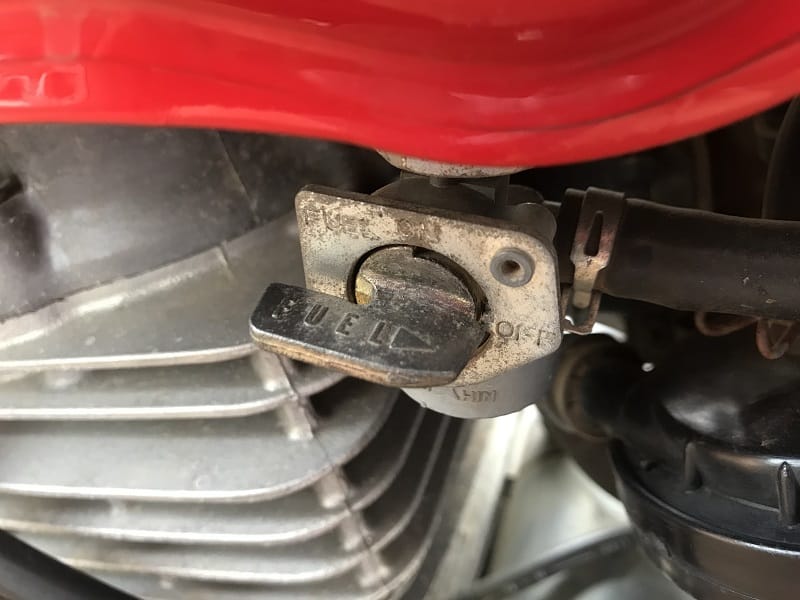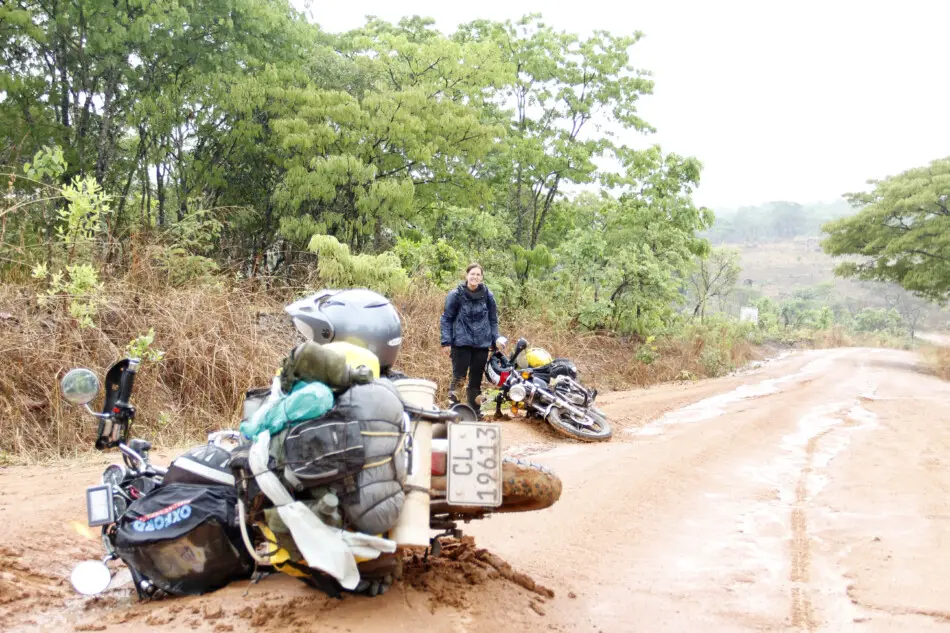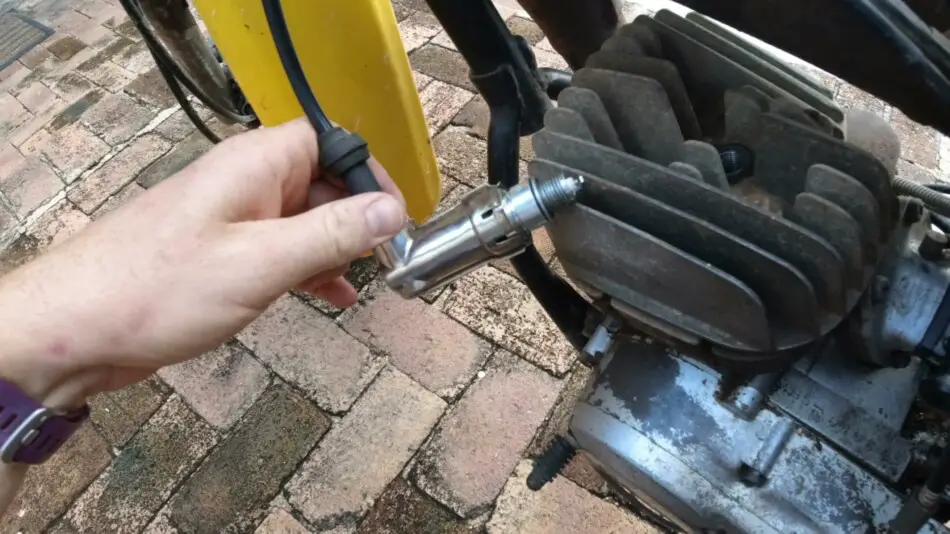If you’ve ever owned a motorcycle that keeps flooding, you’ll understand how frustrating it can be. You get dressed, push the bike out of the garage, hit the starter, but all you hear is the engine cranking. No luck… Oh, and you smell gasoline. You’re bike is flooded (again!)
A motorcycle can flood if you open the throttle while hitting the starter. A flooded carburetor can also be caused by leaving the petcock valve open, a worn or dirty needle and seat, an incorrect float level, or dropping your bike. A problem with the ignition system may also result in a flooded combustion chamber.
There are many reasons why your motorcycle may flood, but most are easy to fix yourself. Let’s have a closer look at the reasons your bike keeps flooding as well as how to prevent each one. Later in the post, we’ll look at how to fix a flooded motorcycle.
If your bike smells like gas, you may want to read this post as well.
Why Does My Motorcycle Keep Flooding
Flooding occurs when there is too much fuel in the combustion chamber. The engine requires a specific air-to-fuel mixture to ignite and if there is too much fuel, your bike won’t start. Gas can flood the engine for various reasons.
Opening the throttle before starting the engine
When you start your motorcycle you should not have to touch the throttle until after the engine has started. A motorcycle with electronic fuel injection will automatically calculate and mix the correct air-to-fuel ratio to start the motorcycle, regardless of the ambient temperature.
On a motorcycle with a carburetor, you need to close (switch on) the choke when it is cold outside. This will allow less air into the intake, which in turn richens the fuel mixture. If you open the throttle before or during cranking the engine, more fuel will be delivered to an already rich mixture which may cause the bike to flood.
PREVENT IT: When you start the motorcycle, leave the throttle alone and only use the choke if it is cold outside. .
Forgetting to close the petcock valve
On older motorcycles with carburetors, it is good practice to close the petcock valve on the fuel tank outlet. This will prevent any fuel to flow into the carburetor while it has not been ridden for a couple of days. The reason why engines flood on older motorcycles is because gravity pushes the fuel from the higher gas tank down into the lower carb float bowl past the needle and seat.

In theory, the needle and seat in your carburetor should shut tight enough to prevent fuel to seep past and into the float bowl. The pressure due to gravity and the high mounted gas tank is often too much for a worn-out needle and seat.
PREVENT IT: Always close the gas tank petcock valve when you switch off the engine for longer than a couple of minutes. Even better is to close the petcock just as you stop the bike. Leave the bike to idle until it starts to splutter. This means that the carb float bowl is almost empty and your engine don’t stand a chance of flooding.
Dirty or worn-out needle and seat
As mentioned earlier, the needle and seat in your carburetor float bowl regulates the fuel flow into the carburetor from the gas tank. If there is dirt in the carb float bowl, some of it can get stuck in the needle and seat, and prevent it from closing all the way. This will cause gas to flow into the float bowl and overfill it which causes flooding.
If you’ve ever wondered what the difference is between a constant velocity (CV) carb and a slide carb, check out this post I wrote once you’re done here.
The needle and seat is made from soft metals and will wear out over time. If this happens, if won’t close properly and your float bowl fill flood with gas.
PREVENT IT: Clean your carburetor and float bowl properly and/or replace your needle and seat. This is very easy on most bikes. Just search for it on YouTube.
Motorcycle fell over
If your bike fell over and it is equipped with a carburetor, there is a good chance it will flood. This has happened to me many times before, especially on my old Honda XR650L (which I regularly dropped!).

The float bowl on a carburetor works the same as a toilet bowl. As the bowl fills up with gas, a float inside rises up and opens an inlet valve (needle and seat). This allows gas to run in from the gas tank to fill up the bowl to a specified level. If you drop the bike, the float will move and open the needle and seat which will flood the carb.
PREVENT IT: After you’ve dropped your bike, let it stand for 10-15 minutes before attempting to start it. If this doesn’t help, drain the carb float bowl at the drain screw at the bottom of the carb.
Float level is set too high
If your motorcycle carburetor’s float level is set too high, too much gas will enter the carburetor float bowl which will cause it to flood. If the gas level in the bowl is too high, gas will be sucked in through one of the jets when it shouldn’t be, which will cause a too rich fuel mixture which will not ignite.
PREVENT IT: Your float level in your carburetor will only be disturbed if you remove the float bowl from the carb body, so if you haven’t opened the carb recently, this is unlikely to be your problem. If you did open the carb and accidentally bent the float arm, you need to reset it. This can be a fiddly job and it is best to leave it to an expert if you are unsure.
I once fiddled with my float level in the middle of nowhere in Western Tanzania. Luckily there was a bush mechanic who could help me and luckily I was riding a cheap Chinese delivery bike for which there are lots of parts all over Africa.
Faulty ignition system
Many motorcycle woes that looks and smells like a fuel problem is caused by an electric issue. If your spark plugs are not sparking properly, they won’t ignite the air-fuel mixture in the combustion chambers properly. When this happens, excess fuel can build up in the cylinders which will cause your engine to flood.
Test for spark by removing the spark plug from the engine and grounding it against the outside of the motor or any metal surface. Crank the engine and check for a strong blue spark. If you have a strong blue spark, your flooding is most likely caused by one of the fuel-related issues described earlier. If the spark is weak, orange, or non-existent, you need to fix your ignition system.
For a detailed post on how to fix a no-spark condition on your motorcycle, check out this post I wrote.

PREVENT IT: Ensure that your spark plug(s) are properly gapped and in good condition. Test your ignition leads and coil for the correct resistance, and ensure your ignition timing is correct.
How to Start a Bike That is Flooded
If this is the first time your bike is flooded, you can try the following to get it running again.
NOTE: I assume your engine is flooded with gas, not water or oil (that’s a whole different story!)
Turn the choke off and keep the throttle pinned wide open. While holding the throttle open, crank the engine until it starts. This will clear the combustion chamber from excess fuel and allow the engine to start. Don’t crank for more than 10 seconds at a time, otherwise the starter may overheat and burn out.
If your bike still won’t start and there is a strong smell of gas, you may have to remove the spark plug(s) to let the excess fuel evaporate from the cylinder(s). Remove the spark plug and if it is wet, leave it out for a few minutes to dry. You may also want to crank the engine a few times to let the piston shoot out any excess fuel from the cylinder.
This should get you going again, but if your bike keeps flooding you need to look for the source of the problem and address it.
Conclusion
A bike that keeps flooding can be a real pain in the backside (or right leg on a bike with a kickstart – ask me how I know!) Take a methodical approach and find the source of the problem to get your bike starting easily every time.
Happy riding!
